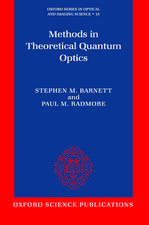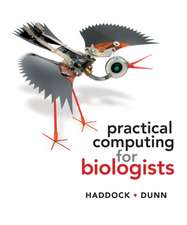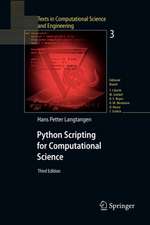Matrices: Methods and Applications: Oxford Applied Mathematics and Computing Science Series
Stephen Barnetten Limba Engleză Paperback – 3 mai 1990
Preț: 541.00 lei
Preț vechi: 1085.25 lei
-50% Nou
Puncte Express: 812
Preț estimativ în valută:
103.52€ • 108.58$ • 86.18£
103.52€ • 108.58$ • 86.18£
Carte tipărită la comandă
Livrare economică 21-27 martie
Preluare comenzi: 021 569.72.76
Specificații
ISBN-13: 9780198596806
ISBN-10: 0198596804
Pagini: 466
Ilustrații: line figures
Dimensiuni: 138 x 216 x 25 mm
Greutate: 0.58 kg
Ediția:New.
Editura: Clarendon Press
Colecția Clarendon Press
Seria Oxford Applied Mathematics and Computing Science Series
Locul publicării:Oxford, United Kingdom
ISBN-10: 0198596804
Pagini: 466
Ilustrații: line figures
Dimensiuni: 138 x 216 x 25 mm
Greutate: 0.58 kg
Ediția:New.
Editura: Clarendon Press
Colecția Clarendon Press
Seria Oxford Applied Mathematics and Computing Science Series
Locul publicării:Oxford, United Kingdom
Cuprins
How matrices arise; Basic algebra of matrices; Unique solution of linear equations; Determinant and inverse; Rank, non-unique solution of equations, and applications; Eigenvalues and eigenvectors; Quadratic and hermitian forms; Canonical forms; Matrix functions; Generalized inverses; Polynomials, stability, and matrix equations; Polynomial and rational matrices; Patterned matrices; Miscellaneous topics; Bibliography; Index.
Recenzii
'matrix methods comprise an important component in any "tool kit" of applied mathematics ... This wide-ranging textbook provides a clearly written and up-to-date account of these methods suitable for both undergraduates and more advanced students.'Extrait de L'Enseignement Mathématique
'this wide-ranging, clearly written account is an ideal reference for both undergraduates and researchers'Mathematika, 38 (1991)
'It is very well written, in an informal style that has become the author's trademark. Students will love this book: It provides an easy access to matrix theory, its main facts and ideas, illustrated with many concrete examples. Users will appreciate this book for its encylopedic coverage and eclectic applications. The wealth of modern, advanced material, which Barnett managed to pack in this small volume, is impressive. Much of this material is given in hundreds of exercises (in each section) and problems (following each section), which makes this an excellent choice for a text, or supplement, for a first course in matrix theory and methods. The promised topics (matrix theory, methods & applications) are covered very well ... excellent text.'Adi Ben-Israel, Rutgers University, IMAGE, Volume 2, Number 2, (Issue 8) January 1992
'This book was found to be a very useful reference for matrix mehods and theories. The range of topics covered is large. This is an attractive book providing a down-to-earth approach and will especially meet the matrix theory requirements of both undergraduate and postgraduate science and engineering students. At #17.50 and 450 printed pages it represents good value for money.'A.A.P. Gibson, UMIST, International Journal of Electrical Engineering Education, Volume 29, No. 3
'The book serves very well as an introduction to matrix methods and applications, and also as a reference for the more advanced student, scientist or engineer. The book is written in a readable style and I am sure will be warmly welcomed by lecturers and students.'Alan Zinober, Journal of the Operational Research Society Vol. 43, No. 12, 1992
'this wide-ranging, clearly written account is an ideal reference for both undergraduates and researchers'Mathematika, 38 (1991)
'It is very well written, in an informal style that has become the author's trademark. Students will love this book: It provides an easy access to matrix theory, its main facts and ideas, illustrated with many concrete examples. Users will appreciate this book for its encylopedic coverage and eclectic applications. The wealth of modern, advanced material, which Barnett managed to pack in this small volume, is impressive. Much of this material is given in hundreds of exercises (in each section) and problems (following each section), which makes this an excellent choice for a text, or supplement, for a first course in matrix theory and methods. The promised topics (matrix theory, methods & applications) are covered very well ... excellent text.'Adi Ben-Israel, Rutgers University, IMAGE, Volume 2, Number 2, (Issue 8) January 1992
'This book was found to be a very useful reference for matrix mehods and theories. The range of topics covered is large. This is an attractive book providing a down-to-earth approach and will especially meet the matrix theory requirements of both undergraduate and postgraduate science and engineering students. At #17.50 and 450 printed pages it represents good value for money.'A.A.P. Gibson, UMIST, International Journal of Electrical Engineering Education, Volume 29, No. 3
'The book serves very well as an introduction to matrix methods and applications, and also as a reference for the more advanced student, scientist or engineer. The book is written in a readable style and I am sure will be warmly welcomed by lecturers and students.'Alan Zinober, Journal of the Operational Research Society Vol. 43, No. 12, 1992
















